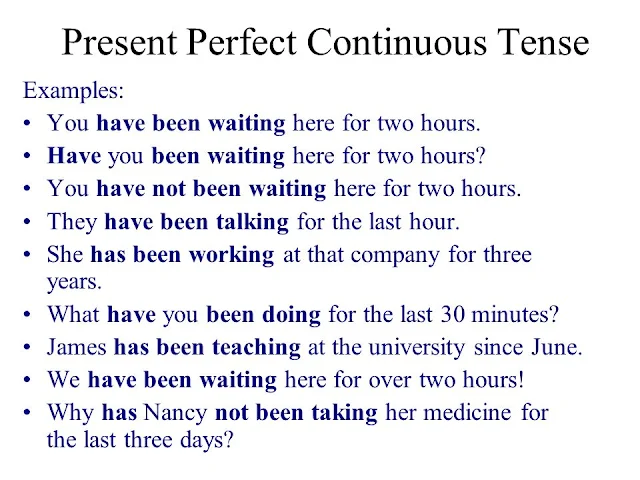Present perfect continuous tense
The present perfect continuous tense is made up of the present perfect tense of the verb to be: have been or has been and the present participle of the main verb (verb + ing)
The Present Perfect Continuous is:
used for an action that began in the past and is still continuing.
Examples:
- Cecilia and I have been talking about getting married.
- They have been trying to contact her.
- Your dogs have been barking since early this morning.
used for an action that began and just finished in the past.
Examples:
- Thank goodness you have arrived. We have been waiting for you.
- My hands are very dirty as I have been repairing the car.
- Why did you not answer your phone? I have been calling you.
used without mention of time
Examples:
- They have been having a lot of difficulties with their new computer system. (describes a difficult situation that is not over.)
- This is the second jigsaw we have been playing.
- A party of rescuers and volunteers has been looking for the missing
used with all (all day, all evening, all week) to indicate duration of an activity, and adverbs such as lately, etc.,
Examples:
- He has been suffering from toothache all day.
- She has been spending all day looking for her cat.
- The party has been going on all night.
- I have been feeling ill lately.
Present perfect continuous tense in questions
Examples:
- How long have you been growing your beard?
- How much money have you been borrowing from your grandmother?
- Have you been riding my bicycle without my permission?
| Statement: | subject | + | have/has | + | been | + | (verb + -ing) |
| They | have | been | playing. | ||||
| He | has | been | running. | ||||
| Question form: | have/has | + | subject | + | been | + | (verb + -ing) |
| Have | they | been | playing? | ||||
| Has | he | been | running? |
Present perfect continuous and present perfect tenses
The present perfect continuous and the present perfect tenses do not differ much in meaning.
Examples:
- He has been selling pencils for two years.
- He has sold pencils for two years.
- We have been telling the children about their table manners.
- We have told the children about their table manners.
The present perfect continuous and the present perfect tenses are used in the same way with for, since, ever since, etc.
Examples:
- Grandpa has been playing hide-and-seek with the grandchildren forhours.
- Grandpa has played hide-and-seek with the grandchildren for hours.
- I have been looking for the missing piece of the jigsaw since ten o'clock.
- I have looked for the missing piece of the jigsaw since ten o'clock.
- He has been working there ever since he fell in love with a woman.
- He has worked there ever since he fell in love with a woman.
Verbs not used with present perfect continuous
There are verbs that cannot be used with the present perfect continuous tense: believe, decide, hate, know, recognize, want, etc. Use the present perfect tense instead.
Examples:
- No: Julia has been deciding to buy a big teddy bear.
- Yes: Julia has decided to buy a big teddy bear.
- No: She has been hating cockroaches and spiders since she was a small girl.
- Yes: She has hated cockroaches and spiders since she was a small girl.
- No: His parents and mine have been wanting to practise yoga together.
- Yes: His parents and mine have wanted to practise yoga together.














No comments